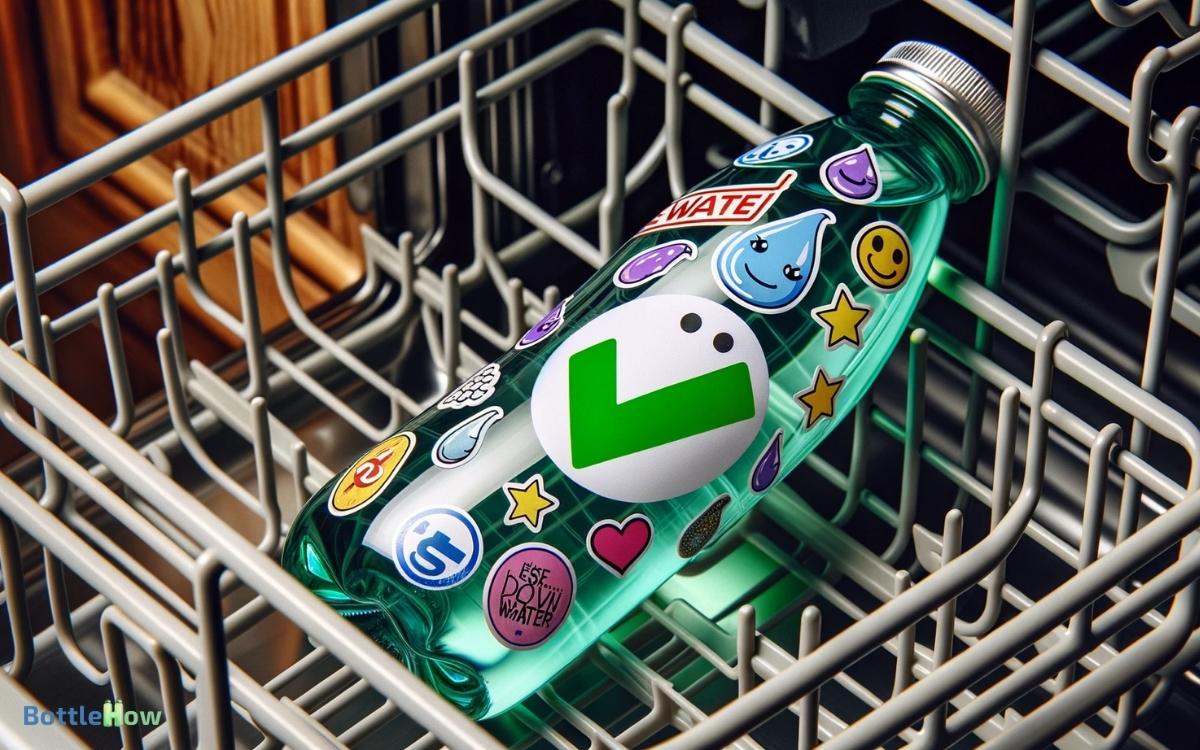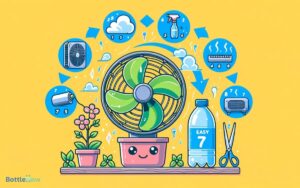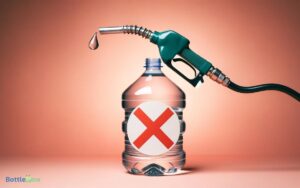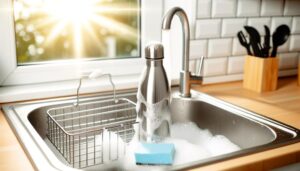Can Water Bottle Stickers Go in the Dishwasher? Yes!
Putting water bottle stickers in the dishwasher isn’t advisable due to high heat and pressure, which can degrade sticker materials and adhesives.
Vinyl and laminated stickers offer some resistance, but adhesives might still break down, causing peeling and fading.
Stickers made from paper are particularly susceptible to damage. Silicone and acrylic adhesives perform better but aren’t immune to the dishwasher’s harsh environment.
Hand washing is safer and preserves sticker life, allowing you to control water temperature and pressure. If you’re interested in maintaining sticker durability and appearance, there are more in-depth tips and methods to explore.

Key Takeaways
Sticker Material Types
When selecting water bottle stickers, you’ll come across various material types, each with distinct properties that impact durability and dishwasher safety.
Vinyl stickers are popular due to their water resistance and flexibility, but not all vinyl can withstand dishwasher heat.
Polyester stickers offer excellent durability and are generally more heat-resistant, making them a safer choice. Paper stickers, while economical, lack water resistance and will degrade quickly in a dishwasher.
Additionally, laminated stickers have an extra protective layer, enhancing their lifespan under high temperatures and water exposure.
Always confirm the manufacturer’s specifications for heat and water resistance to guarantee sticker longevity.
Prioritize materials designed for high durability and water resistance to maintain appearance and adhesion after multiple dishwasher cycles.
Adhesive Durability
When examining adhesive durability, you must consider how well the adhesive withstands high temperatures during dishwasher cycles.
Different adhesives exhibit varying levels of heat resistance, which directly impacts the longevity of the sticker.
Ensuring the adhesive quality meets safety standards prevents peeling and potential ingestion hazards.
Heat Resistance Factors
Understanding the adhesive durability of water bottle stickers under high temperatures is crucial for guaranteeing they remain intact through multiple dishwasher cycles.
You need to take into account several factors that influence adhesive performance:
- Temperature Threshold: Check if the adhesive can endure high dishwasher temperatures, which often exceed 150°F (65°C).
- Chemical Resistance: Detergents and rinse aids can degrade adhesives, impacting sticker longevity.
- Moisture Absorption: High humidity and water exposure can weaken the adhesive bond.
- Material Compatibility: Ensure the adhesive is suitable for the sticker material and the water bottle surface.
- Curing Process: Properly cured adhesives often perform better under heat stress.
Adhesive Quality Variations
Different adhesives exhibit varying levels of durability, and recognizing these variations is crucial for selecting stickers that will withstand the rigors of dishwasher cycles.
Pressure-sensitive adhesives (PSAs) are common but vary in heat and water resistance. Acrylic-based PSAs typically offer superior durability compared to rubber-based ones. Silicone adhesives also provide excellent heat resistance but can be more expensive.
When evaluating adhesives, consider the temperature stability and water exposure your stickers will face.
Confirming the adhesive can endure high temperatures and repeated water immersion will help maintain sticker integrity.
Always verify manufacturer specifications regarding dishwasher safety. Ignoring adhesive quality can lead to peeling, residue, or even damaging your dishwasher. Select the right adhesive to guarantee your stickers remain intact.
Dishwasher Heat Effects
The high temperatures in dishwashers can cause water bottle stickers to peel, fade, or deteriorate, impacting their longevity and appearance. When you expose stickers to such heat, the adhesive can weaken, and the material can warp.
To help you understand the risks, consider the following effects:
- Adhesive breakdown – Heat can soften and dissolve the sticker’s adhesive, leading to detachment.
- Color fading – Prolonged exposure to high temperatures can cause colors to fade.
- Material warping – Heat can distort the sticker material, causing it to lose shape.
- Print smudging – High heat can blur or smudge printed designs.
- Safety hazard – Peeling stickers can clog dishwasher filters or drains.
To maintain sticker integrity, consider hand washing your water bottles.
Water Pressure Impact
To guarantee the longevity and adhesion of water bottle stickers, it’s important to consider the impact of high water pressure.
This pressure can significantly affect the durability and attachment of stickers on your bottle, potentially causing peeling or complete detachment.
When water jets come into contact with your bottle, the force can weaken the bond of the adhesive to the surface.
This is particularly relevant for stickers with elaborate designs or those not specifically labeled as dishwasher-safe.
With repeated exposure to such pressure, the edges of the stickers may start to lift, giving them a worn and messy appearance.
Moreover, high-pressure water has the potential to seep beneath the sticker, compromising its overall integrity.
From a safety standpoint, torn stickers could potentially block your dishwasher’s filter, resulting in maintenance issues.
To prolong the lifespan of your stickers, always refer to the manufacturer’s recommendations regarding dishwasher use for both your bottle and its stickers.
Hand Washing Benefits
Given the potential risks associated with high water pressure in dishwashers, hand washing your water bottle and its stickers offers a safer and more effective alternative to preserve their integrity. Harsh dishwasher cycles can cause stickers to peel or fade, diminishing their appearance over time. This is especially true for items like a Peloton water bottle dishwasher users might place on the top rack, as the heat and pressure can weaken adhesive bonds. By opting for gentle handwashing, you can extend the lifespan of both your bottle and its design while ensuring a thorough clean.
Manual cleaning allows you to control the water temperature and pressure, reducing the likelihood of sticker damage or peeling.
Additionally, it provides an opportunity for a thorough inspection of the bottle and stickers, guaranteeing they remain in good condition.
Hand washing benefits include:
- Temperature Control: Prevents thermal shock to adhesives.
- Pressure Regulation: Avoids high-pressure water that can peel stickers.
- Detailed Inspection: Detects early signs of wear and tear.
- Residue Removal: Ensures thorough cleaning without harsh detergents.
- Personalized Care: Adapts to specific materials and finishes.
Protective Coatings
When evaluating protective coatings for water bottle stickers, you’ll need to comprehend the types available, such as UV-resistant and waterproof coatings.
Evaluate the durability of each type in dishwasher conditions, as some may degrade over time. Additionally, consider the application methods to guarantee they provide a consistent and safe barrier.
Types of Coatings
Protective coatings for water bottle stickers, such as laminates and UV coatings, guarantee durability and resistance to harsh conditions like dishwasher cycles.
These coatings protect the sticker surface from high temperatures, moisture, and chemical detergents, ensuring longevity.
Here’s a detailed look at common types:
- Laminates: Provide a clear, durable shield against physical wear and tear.
- UV Coatings: Defend against sun exposure, preventing fading and cracking.
- Acrylic Coatings: Offer robust chemical resistance and flexibility.
- Polyurethane Coatings: Known for their excellent abrasion resistance.
- Epoxy Coatings: Deliver superior hardness and chemical resistance but can be less flexible.
Understanding these coatings helps you choose the most suitable option, ensuring your stickers withstand rigorous dishwasher conditions without degrading. Always prioritize safety and material compatibility when selecting your protective coatings.
Durability in Dishwashers
Ensuring your water bottle stickers endure repeated dishwasher cycles involves understanding how various protective coatings perform under such conditions. You need to take into account the material’s resistance to heat, water, and detergent.
Here’s a quick comparison of common coatings:
| Coating Type | Heat Resistance | Water/Dishwasher-Safe |
|---|---|---|
| Vinyl Laminate | High | Yes |
| UV Coating | Moderate | Sometimes |
| Acrylic Coating | Low | No |
Vinyl laminate is ideal due to its high heat resistance and durability. UV coatings offer moderate protection but may degrade over time. Acrylic coatings, however, tend to peel and fade quickly.
Always check manufacturer guidelines for specific recommendations, as improper coatings can lead to sticker damage and potentially unsafe water bottles.
Application Methods
Applying protective coatings to water bottle stickers demands a methodical approach to guarantee they remain intact and vibrant through multiple dishwasher cycles. You’ll need to make sure the coatings are applied uniformly and allowed to cure properly.
Here’s a step-by-step guide to enhance durability:
- Clean Surface: Make sure the bottle is free from dirt and oils.
- Select Coating: Use a dishwasher-safe, clear sealant specifically designed for vinyl.
- Apply Evenly: Use a brush or spray method to distribute the coating evenly.
- Dry Time: Allow sufficient drying time as per the manufacturer’s instructions.
- Multiple Layers: Consider applying multiple thin layers for added protection.
Removable Vs. Permanent
When selecting water bottle stickers, it’s crucial to comprehend the distinctions between removable and permanent options to guarantee they meet your specific needs and safety requirements.
Removable stickers use a less aggressive adhesive, making them easy to peel off without leaving residue.
They’re ideal if you frequently change designs or need to replace them often. However, they mightn’t withstand dishwasher cycles well.
Permanent stickers, on the other hand, employ a stronger adhesive, ensuring durability and longevity, even through multiple washes. But they can be challenging to remove, potentially leaving residue or damage.
Assess your usage patterns and dishwasher habits carefully to decide which type best suits your water bottle, ensuring both practicality and safety.
Long-term Care Tips
Maintaining the longevity of your water bottle stickers involves regular cleaning and mindful handling to prevent peeling and fading. Using specific techniques can guarantee they remain vibrant and secure.
- Hand Wash Only: Always wash your bottle by hand using mild soap and water.
- Avoid Harsh Chemicals: Steer clear of bleach or abrasive cleaners that can deteriorate the adhesive and design.
- Dry Thoroughly: Make sure the bottle is completely dry before reapplying stickers to prevent moisture damage.
- Temperature Control: Avoid exposing your bottle to extreme temperatures, as heat can cause stickers to peel.
- Gentle Handling: Handle your bottle with care, avoiding rough surfaces or heavy friction that could wear down the stickers.
Conclusion
In short, not all water bottle stickers can survive the dishwasher’s wrath. Some adhesives melt faster than ice cream on a hot day, while others might hang on a bit longer. The heat and water pressure can turn your beloved stickers into a gooey mess.
Hand washing with care, and considering protective coatings, extends their life. For best results, always check if your sticker is dishwasher-safe to avoid sticker heartbreak.





